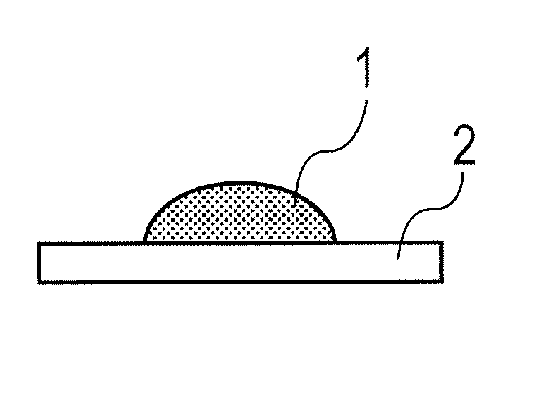Photocured product and method for producing the same
a technology of photolithography and product, applied in the field of photolithography products, can solve the problems of large mold release force, inability to go beyond the diffraction limit of exposing light, and inability to produce photolithography-based finer patterns, etc., to achieve the effect of improving pattern defects and favorable pattern precision
- Summary
- Abstract
- Description
- Claims
- Application Information
AI Technical Summary
Benefits of technology
Problems solved by technology
Method used
Image
Examples
synthesis example 1
Synthesis of Fluorine Atom-Containing Surfactant (C-1)
[0163](1) The inside of a 300-mL reactor was kept in a nitrogen atmosphere, while the following reagents and solvents were added into this reactor:
[0164]Hexaethylene glycol (PEG6): 26.5 g (93.9 mmol, 1.0 eq.)
[0165]Carbon tetrachloride (CCl4): 36.1 g (235 mmol, 2.5 eq.)
[0166]Tetrahydrofuran (THF): 106 mL
[0167]Next, the reaction solution was cooled to −30° C. Next, dimethylaminophosphine (15.3 g, 93.9 mmol, 1.0 eq.) diluted in THF (24 mL) was gradually added to the reaction solution over 2 hours, and the mixture was then stirred at the same temperature for 30 minutes. Next, the reactor was taken out of the cooling bath, and the reaction solution was then stirred at room temperature for 2 hours. Subsequently, city water (250 mL) was added to the reaction solution (pale yellow suspension) to separate the reaction solution into two layers (CCl4 layer and aqueous layer). Then, the aqueous layer was collected. Subsequently, the aqueous ...
synthesis example 2
Synthesis of Fluorine Atom-Containing Surfactant (C-2)
[0171](1) The inside of a 100-mL reactor was kept in a nitrogen atmosphere, while the following reagents and solvents were added into this reactor:
[0172]Hexapropylene glycol (P400): 20 g (50 mmol, 1.0 eq.)
[0173]Carbon tetrachloride (CCl4): 19.2 g (125 mmol, 2.5 eq.)
[0174]Tetrahydrofuran (THF): 100 mL)
[0175]Next, the reaction solution was cooled to −30° C. Next, dimethylaminophosphine (8.16 g, 10 mmol, 1.0 eq.) diluted in THF (30 mL) was gradually added to the reaction solution over 2 hours, and the mixture was then stirred at the same temperature for 30 minutes. Next, the reactor was taken out of the cooling bath, and the reaction solution was then stirred at room temperature for 2 hours. Subsequently, city water (350 mL) was added to the reaction solution (pale yellow suspension) to separate the reaction solution into two layers (CCl4 layer and aqueous layer). Then, the aqueous layer was collected. Subsequently, the aqueous laye...
example 1
(1) Preparation of Photocurable Composition
[0179]First, the following reagents and solvents were mixed:
[0180](component A) isobornyl acrylate (manufactured by Kyoeisha Chemical Co., Ltd.): 62 parts by weight
[0181](component A) 1,6-hexanediol diacrylate (manufactured by Osaka Organic Chemical Industry, Ltd.): 22 parts by weight
[0182](component A) Medol 10 (manufactured by Osaka Organic Chemical Industry, Ltd.): 16 parts by weight
[0183](component B) Irgacure 369 (manufactured by Ciba Japan Co., Ltd.): 3 parts by weight
[0184](component C-1) fluorine atom-containing surfactant (F(CF2)6CH2(OCH2CH2)6OH): 2 parts by weight
[0185]Next, a mixed solution of components A, B and C-1 was filtered through a 0.2 μm filter made of tetrafluoroethylene to obtain photocurable composition (a-1) of this Example (Example 1).
[0186]The surface tension of the obtained photocurable composition was measured using an automatic surface tensiometer CBVP-A3 (manufactured by Kyowa Interface Science Co., Ltd.) and c...
PUM
| Property | Measurement | Unit |
|---|---|---|
| Shape | aaaaa | aaaaa |
Abstract
Description
Claims
Application Information
 Login to View More
Login to View More - R&D
- Intellectual Property
- Life Sciences
- Materials
- Tech Scout
- Unparalleled Data Quality
- Higher Quality Content
- 60% Fewer Hallucinations
Browse by: Latest US Patents, China's latest patents, Technical Efficacy Thesaurus, Application Domain, Technology Topic, Popular Technical Reports.
© 2025 PatSnap. All rights reserved.Legal|Privacy policy|Modern Slavery Act Transparency Statement|Sitemap|About US| Contact US: help@patsnap.com


